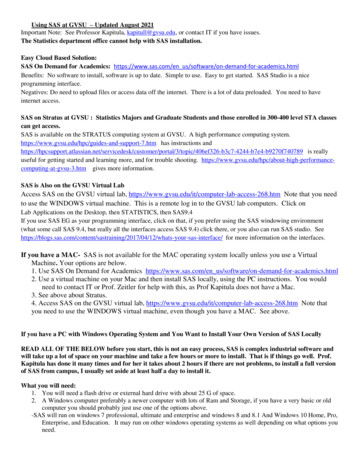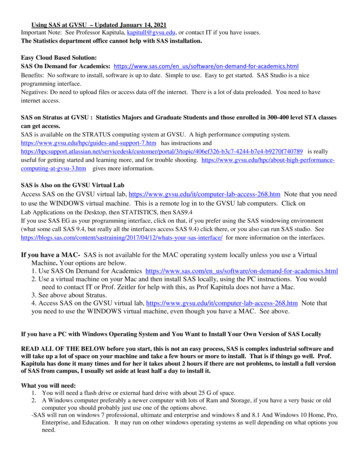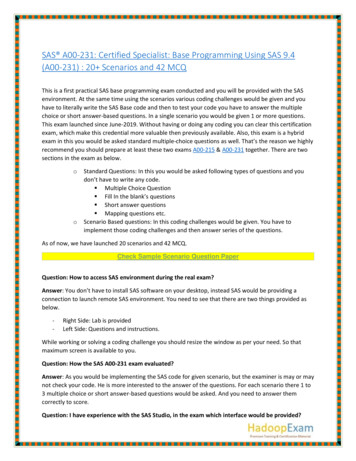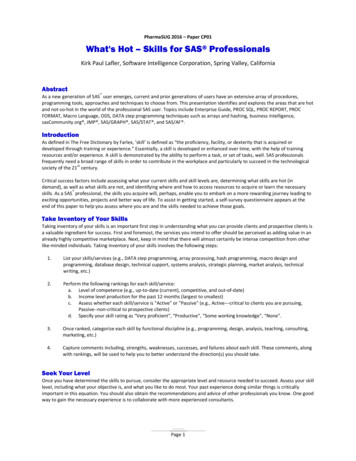
Transcription
SAS/STAT 13.1 User’s GuideThe MIANALYZEProcedure
This document is an individual chapter from SAS/STAT 13.1 User’s Guide.The correct bibliographic citation for the complete manual is as follows: SAS Institute Inc. 2013. SAS/STAT 13.1 User’s Guide.Cary, NC: SAS Institute Inc.Copyright 2013, SAS Institute Inc., Cary, NC, USAAll rights reserved. Produced in the United States of America.For a hard-copy book: No part of this publication may be reproduced, stored in a retrieval system, or transmitted, in any form or byany means, electronic, mechanical, photocopying, or otherwise, without the prior written permission of the publisher, SAS InstituteInc.For a web download or e-book: Your use of this publication shall be governed by the terms established by the vendor at the timeyou acquire this publication.The scanning, uploading, and distribution of this book via the Internet or any other means without the permission of the publisher isillegal and punishable by law. Please purchase only authorized electronic editions and do not participate in or encourage electronicpiracy of copyrighted materials. Your support of others’ rights is appreciated.U.S. Government License Rights; Restricted Rights: The Software and its documentation is commercial computer softwaredeveloped at private expense and is provided with RESTRICTED RIGHTS to the United States Government. Use, duplication ordisclosure of the Software by the United States Government is subject to the license terms of this Agreement pursuant to, asapplicable, FAR 12.212, DFAR 227.7202-1(a), DFAR 227.7202-3(a) and DFAR 227.7202-4 and, to the extent required under U.S.federal law, the minimum restricted rights as set out in FAR 52.227-19 (DEC 2007). If FAR 52.227-19 is applicable, this provisionserves as notice under clause (c) thereof and no other notice is required to be affixed to the Software or documentation. TheGovernment’s rights in Software and documentation shall be only those set forth in this Agreement.SAS Institute Inc., SAS Campus Drive, Cary, North Carolina 27513-2414.December 2013SAS provides a complete selection of books and electronic products to help customers use SAS software to its fullest potential. Formore information about our offerings, visit support.sas.com/bookstore or call 1-800-727-3228.SAS and all other SAS Institute Inc. product or service names are registered trademarks or trademarks of SAS Institute Inc. in theUSA and other countries. indicates USA registration.Other brand and product names are trademarks of their respective companies.
Gain Greater Insight into YourSAS Software with SAS Books. Discover all that you need on your journey to knowledge and empowerment.support.sas.com/bookstorefor additional books and resources.SAS and all other SAS Institute Inc. product or service names are registered trademarks or trademarks of SAS Institute Inc. in the USA and other countries. indicates USA registration. Other brand and product names aretrademarks of their respective companies. 2013 SAS Institute Inc. All rights reserved. S107969US.0613
Chapter 62The MIANALYZE ProcedureContentsOverview: MIANALYZE Procedure . . . . . . . . . . . . . . . . . . . . . . . . . . . . . .5172Getting Started: MIANALYZE Procedure . . . . . . . . . . . . . . . . . . . . . . . . . . .5173Syntax: MIANALYZE Procedure . . . . . . . . . . . . . . . . . . . . . . . . . . . . . . .5176PROC MIANALYZE Statement . . . . . . . . . . . . . . . . . . . . . . . . . . . . .5176BY Statement . . . . . . . . . . . . . . . . . . . . . . . . . . . . . . . . . . . . . .5179CLASS Statement . . . . . . . . . . . . . . . . . . . . . . . . . . . . . . . . . . . .5180MODELEFFECTS Statement . . . . . . . . . . . . . . . . . . . . . . . . . . . . . .5180STDERR Statement . . . . . . . . . . . . . . . . . . . . . . . . . . . . . . . . . . .5180TEST Statement . . . . . . . . . . . . . . . . . . . . . . . . . . . . . . . . . . . . .5181Details: MIANALYZE Procedure . . . . . . . . . . . . . . . . . . . . . . . . . . . . . . .5182Input Data Sets . . . . . . . . . . . . . . . . . . . . . . . . . . . . . . . . . . . . . .5182Combining Inferences from Imputed Data Sets . . . . . . . . . . . . . . . . . . . . .5187Multiple Imputation Efficiency . . . . . . . . . . . . . . . . . . . . . . . . . . . . .5188Multivariate Inferences . . . . . . . . . . . . . . . . . . . . . . . . . . . . . . . . . .Testing Linear Hypotheses about the Parameters . . . . . . . . . . . . . . . . . . . .51885190Examples of the Complete-Data Inferences . . . . . . . . . . . . . . . . . . . . . . .5190ODS Table Names . . . . . . . . . . . . . . . . . . . . . . . . . . . . . . . . . . . .5192Examples: MIANALYZE Procedure . . . . . . . . . . . . . . . . . . . . . . . . . . . . . .5193Example 62.1: Reading Means and Standard Errors from a DATA Data Set . . . . .5195Example 62.2: Reading Means and Covariance Matrices from a DATA COV Data Set 5197Example 62.3: Reading Regression Results from a DATA EST Data Set . . . . . . .5200Example 62.4: Reading Mixed Model Results from PARMS and COVB Data Sets5202Example 62.5: Reading Generalized Linear Model Results . . . . . . . . . . . . . .5206Example 62.6: Reading GLM Results from PARMS and XPXI Data Sets . . . . .5208Example 62.7: Reading Logistic Model Results from a PARMS Data Set . . . . . .5209Example 62.8: Reading Mixed Model Results with Classification Covariates . . . . .5211Example 62.9: Reading Nominal Logistic Model Results . . . . . . . . . . . . . . .5213Example 62.10: Using a TEST statement . . . . . . . . . . . . . . . . . . . . . . . .5218Example 62.11: Combining Correlation Coefficients . . . . . . . . . . . . . . . . . .5220Example 62.12: Sensitivity Analysis with Control-Based Pattern Imputation . . . . .5223Example 62.13: Sensitivity Analysis with Tipping-Point Approach . . . . . . . . . .5226References . . . . . . . . . . . . . . . . . . . . . . . . . . . . . . . . . . . . . . . . . . .5231
5172 F Chapter 62: The MIANALYZE ProcedureOverview: MIANALYZE ProcedureThe MIANALYZE procedure combines the results of the analyses of imputations and generates validstatistical inferences. Multiple imputation provides a useful strategy for analyzing data sets with missingvalues. Instead of filling in a single value for each missing value, Rubin’s (1976, 1987) multiple imputationstrategy replaces each missing value with a set of plausible values that represent the uncertainty about theright value to impute.Multiple imputation inference involves three distinct phases:1. The missing data are filled in m times to generate m complete data sets.2. The m complete data sets are analyzed using standard statistical analyses.3. The results from the m complete data sets are combined to produce inferential results.A companion procedure, PROC MI, creates multiply imputed data sets for incomplete multivariate data. Ituses methods that incorporate appropriate variability across the m imputations.The analyses of imputations are obtained by using standard SAS procedures (such as PROC REG) forcomplete data. No matter which complete-data analysis is used, the process of combining results fromdifferent imputed data sets is essentially the same and results in valid statistical inferences that properlyreflect the uncertainty due to missing values. These results of analyses are combined in the MIANALYZEprocedure to derive valid inferences.The MIANALYZE procedure reads parameter estimates and associated standard errors or covariance matrixthat are computed by the standard statistical procedure for each imputed data set. The MIANALYZEprocedure then derives valid univariate inference for these parameters. With an additional assumption aboutthe population between and within imputation covariance matrices, multivariate inference based on Waldtests can also be derived.The MODELEFFECTS statement lists the effects to be analyzed, and the CLASS statement lists theclassification variables in the MODELEFFECTS statement. The variables in the MODELEFFECTS statementthat are not specified in a CLASS statement are assumed to be continuous.When each effect in the MODELEFFECTS statement is a continuous variable by itself, a STDERR statementspecifies the standard errors when both parameter estimates and associated standard errors are stored asvariables in the same data set.For some parameters of interest, you can use TEST statements to test linear hypotheses about the parameters.For others, it is not straightforward to compute estimates and associated covariance matrices with standardstatistical SAS procedures. Examples include correlation coefficients between two variables and ratios ofvariable means. These special cases are described in the section “Examples of the Complete-Data Inferences”on page 5190.
Getting Started: MIANALYZE Procedure F 5173Getting Started: MIANALYZE ProcedureThe Fitness data described in the REG procedure are measurements of 31 individuals in a physical fitnesscourse. See Chapter 83, “The REG Procedure,” for more information. The Fitness1 data set is constructedfrom the Fitness data set and contains three variables: Oxygen, RunTime, and RunPulse. Some values havebeen set to missing, and the resulting data set has an arbitrary pattern of missingness in these three variables.*----------------- Data on Physical Fitness -----------------* These measurements were made on men involved in a physical fitness course at N.C. State University. Only selected variables of Oxygen (oxygen intake, ml per kg body weight per minute), Runtime (time to run 1.5 miles in minutes), and RunPulse (heart rate while running) are used. Certain values were changed to missing for the analysis. -----------*;data Fitness1;input Oxygen RunTime RunPulse @@;datalines;44.609 11.37 17845.313 10.07 18554.2978.65 15659.571.49.8749.22.44.811 11.63 176.11.95 176. 10.85.39.442 13.08 17460.0558.63 17050.541.37.388 14.03 18644.754 11.12 17647.273.51.855 10.33 16649.1568.95 18040.836 10.95 16846.672 10.00.46.774 10.25.50.388 10.08 16839.407 12.63 17446.080 11.17 15645.4419.63 164.8.92.45.118 11.08.39.203 12.88 16845.790 10.47 18650.5459.93 14848.6739.40 18647.920 11.50 17047.467 10.50 170;Suppose that the data are multivariate normally distributed and that the missing data are missing at random(see the “Statistical Assumptions for Multiple Imputation” section in the chapter “The MI Procedure” for adescription of these assumptions). The following statements use the MI procedure to impute missing valuesfor the Fitness1 data set:proc mi data Fitness1 seed 3237851 noprint out outmi;var Oxygen RunTime RunPulse;run;The MI procedure creates imputed data sets, which are stored in the Outmi data set. A variable namedImputation indicates the imputation numbers. Based on m imputations, m different sets of the point andvariance estimates for a parameter can be computed. In this example, m 5 is the default.
5174 F Chapter 62: The MIANALYZE ProcedureThe following statements generate regression coefficients for each of the five imputed data sets:proc reg data outmi outest outreg covout noprint;model Oxygen RunTime RunPulse;by Imputation ;run;The following statements display (in Figure 62.1) output parameter estimates and covariance matrices fromPROC REG for the first two imputed data sets:proc print data outreg(obs 8);var Imputation Type NameIntercept RunTime RunPulse;title 'Parameter Estimates from Imputed Data Sets';run;Figure 62.1 Parameter EstimatesParameter Estimates from Imputed Data 0.003130.00264The following statements combine the five sets of regression coefficients:proc mianalyze data outreg;modeleffects Intercept RunTime RunPulse;run;The “Model Information” table in Figure 62.2 lists the input data set(s) and the number of imputations.Figure 62.2 Model Information TableThe MIANALYZE ProcedureModel InformationData SetNumber of ImputationsWORK.OUTREG5The “Variance Information” table in Figure 62.3 displays the between-imputation, within-imputation, andtotal variances for combining complete-data inferences. It also displays the degrees of freedom for the totalvariance, the relative increase in variance due to missing values, the fraction of missing information, and therelative efficiency for each parameter estimate.
Getting Started: MIANALYZE Procedure F 5175Figure 62.3 Variance Information TableVariance ariance InformationParameterRelativeIncreasein e “Parameter Estimates” table in Figure 62.4 displays a combined estimate and standard error for eachregression coefficient (parameter). Inferences are based on t distributions. The table displays a 95%confidence interval and a t test with the associated p-value for the hypothesis that the parameter is equal tothe value specified with the THETA0 option (in this case, zero by default). The minimum and maximumparameter estimates from the imputed data sets are also displayed.Figure 62.4 Parameter EstimatesParameter EstimatesParameterEstimateStd 06857811.4533270.3598440.06120495% Confidence 3Parameter 11-0.024910Parameter EstimatesParameterTheta0t for H0:Parameter Theta0Pr t InterceptRunTimeRunPulse0007.93-8.43-1.12 .0001 .00010.2695DF23.059123.8838.419
5176 F Chapter 62: The MIANALYZE ProcedureSyntax: MIANALYZE ProcedureThe following statements are available in the MIANALYZE procedure:PROC MIANALYZE options ;BY variables ;CLASS variables ;MODELEFFECTS effects ; label: TEST equation1 , . . . , equationk / options ;STDERR variables ;The BY statement specifies groups in which separate analyses are performed.The CLASS statement lists the classification variables in the MODELEFFECTS statement. Classificationvariables can be either character or numeric.The required MODELEFFECTS statement lists the effects to be analyzed. The variables in the statement thatare not specified in a CLASS statement are assumed to be continuous.The STDERR statement lists the standard errors associated with the effects in the MODELEFFECTSstatement when both parameter estimates and standard errors are saved as variables in the same DATA dataset. The STDERR statement can be used only when each effect in the MODELEFFECTS statement is acontinuous variable by itself.The TEST statement tests linear hypotheses about the parameters. An F statistic is used to jointly test thenull hypothesis (H0 W L D c) specified in a single TEST statement. Several TEST statements can be used.The PROC MIANALYZE and MODELEFFECTS statements are required for the MIANALYZE procedure.The rest of this section provides detailed syntax information for each of these statements, beginning with thePROC MIANALYZE statement. The remaining statements are in alphabetical order.PROC MIANALYZE StatementPROC MIANALYZE options ;The PROC MIANALYZE statement invokes the MIANALYZE procedure. Table 62.1 summarizes the optionsavailable in the PROC MIANALYZE statement.Table 62.1 Summary of PROC MIANALYZE OptionsOptionDescriptionInput Data SetsDATA Specifies the COV, CORR, or EST type data setDATA Specifies the data set for parameter estimates and standard errorsPARMS Specifies the data set for parameter estimatesPARMINFO Specifies the data set for parameter informationCOVB Specifies the data set for covariance matricesXPXI Specifies the data set for .X0 X/ 1 matrices
PROC MIANALYZE Statement F 5177Table 62.1 continuedOptionDescriptionStatistical AnalysisTHETA0 Specifies parameters under the null hypothesisALPHA Specifies the level for the confidence intervalEDF Specifies the complete-data degrees of freedomPrinted OutputWCOVDisplays the within-imputation covariance matrixBCOVDisplays the between-imputation covariance matrixTCOVDisplays the total covariance matrixMULTDisplays multivariate inferencesThe following options can be used in the PROC MIANALYZE statement. They are listed in alphabeticalorder.ALPHA specifies that confidence limits are to be constructed for the parameter estimates with confidence level100.1 /%, where 0 1. The default is ALPHA 0.05.BCOVdisplays the between-imputation covariance matrix.COVB (EFFECTVAR STACKING ROWCOL) SAS-data-setnames an input SAS data set that contains covariance matrices of the parameter estimates from imputeddata sets. If you provide a COVB data set, you must also provide a PARMS data set.The EFFECTVAR option identifies the variables for parameters displayed in the covariance matrix andis used only when the PARMINFO option is not specified. The default is EFFECTVAR STACKING.See the section “Input Data Sets” on page 5182 for a detailed description of the COVB option.DATA SAS-data-setnames an input SAS data set.If the input DATA data set is not a specially structured SAS data set, the data set contains boththe parameter estimates and associated standard errors. The parameter estimates are specified in theMODELEFFECTS statement and the standard errors are specified in the STDERR statement.If the data set is a specially structured input SAS data set, it must have a TYPE of EST, COV, or CORRthat contains estimates from imputed data sets: If TYPE EST, the data set contains the parameter estimates and associated covariance matrices. If TYPE COV, the data set contains the sample means, sample sizes, and covariance matrices.Each covariance matrix for variables is divided by the sample size n to create the covariancematrix for parameter estimates. If TYPE CORR, the data set contains the sample means, sample sizes, standard errors, andcorrelation matrices. The covariance matrices are computed from the correlation matrices andassociated standard errors. Each covariance matrix for variables is divided by the sample size nto create the covariance matrix for parameter estimates.
5178 F Chapter 62: The MIANALYZE ProcedureIf you do not specify an input data set with the DATA or PARMS option, then the most recentlycreated SAS data set is used as an input DATA data set. See the section “Input Data Sets” onpage 5182 for a detailed description of the input data sets.EDF numberspecifies the complete-data degrees of freedom for the parameter estimates. This is used to computean adjusted degrees of freedom for each parameter estimate. By default, EDF 1 and the degrees offreedom for each parameter estimate are not adjusted.MULTMULTIVARIATErequests multivariate inference for the parameters. It is based on Wald tests and is a generalizationof the univariate inference. See the section “Multivariate Inferences” on page 5188 for a detaileddescription of the multivariate inference.PARMINFO SAS-data-setnames an input SAS data set that contains parameter information associated with variables PRM1,PRM2,. . . , and so on. These variables are used as variables for parameters in a COVB data set. Seethe section “Input Data Sets” on page 5182 for a detailed description of the PARMINFO option.PARMS (options) SAS-data-setnames an input SAS data set that contains parameter estimates computed from imputed data sets. Whena COVB data set is not specified, the input PARMS data set also contains standard errors associatedwith these parameter estimates. If multivariate inference is requested, you must also provide a COVB or XPXI data set.The available options are as follows:CLASSVAR FULL LEVEL CLASSVALidentifies the associated classification variables when reading the classification levels fromobservations. The CLASSVAR option is applicable only when the model effects containclassification variables. The default is CLASSVAR FULL.LINK NONE LOGIT GLOGITidentifies the type of parameter estimates. The LINK NONE option (which is the default)indicates the parameter estimates that are derived from a procedure other than the LOGISTICprocedure.The LINK LOGIT option indicates the parameter estimates that are derived from the LOGISTICprocedure for ordinal responses. It is applicable only when the variable Intercept is in the MODELEFFECTS statement and the logistic model has more than two response levels. Otherwise,LINK NONE should be used.The LINK GLOGIT option indicates the parameter estimates that are derived from the LOGISTIC procedure for nominal responses.For a detailed description of the PARMS option, see the section “PARMS ( parms-options) DataSet” on page 5184
BY Statement F 5179TCOVdisplays the total covariance matrix derived by assuming that the population between-imputation andwithin-imputation covariance matrices are proportional to each other.THETA0 numbersMU0 numbersspecifies the parameter values 0 under the null hypothesis D 0 in the t tests for location for theeffects. If only one number 0 is specified, that number is used for all effects. If more than one numberis specified, the specified numbers correspond to effects in the MODELEFFECTS statement in theorder in which they appear in the statement. When an effect contains classification variables, thecorresponding value is not used and the test is not performed.WCOVdisplays the within-imputation covariance matrices.XPXI SAS-data-setnames an input SAS data set that contains the .X0 X/ 1 matrices associated with the parameter estimatescomputed from imputed data sets. If you provide an XPXI data set, you must also provide a PARMS data set. In this case, PROC MIANALYZE reads the standard errors of the estimates from the PARMS data. The standard errors and .X0 X/ 1 matrices are used to derive the covariance matrices.BY StatementBY variables ;You can specify a BY statement with PROC MIANALYZE to obtain separate analyses of observations ingroups that are defined by the BY variables. When a BY statement appears, the procedure expects the inputdata set to be sorted in order of the BY variables. If you specify more than one BY statement, only the lastone specified is used.If your input data set is not sorted in ascending order, use one of the following alternatives: Sort the data by using the SORT procedure with a similar BY statement. Specify the NOTSORTED or DESCENDING option in the BY statement for the MIANALYZEprocedure. The NOTSORTED option does not mean that the data are unsorted but rather that thedata are arranged in groups (according to values of the BY variables) and that these groups are notnecessarily in alphabetical or increasing numeric order. Create an index on the BY variables by using the DATASETS procedure (in Base SAS software).For more information about BY-group processing, see the discussion in SAS Language Reference: Concepts.For more information about the DATASETS procedure, see the discussion in the Base SAS Procedures Guide.
5180 F Chapter 62: The MIANALYZE ProcedureCLASS StatementCLASS variables ;The CLASS statement specifies the classification variables in the MODELEFFECTS statement. Classificationvariables can be either character or numeric. Classification levels are determined from the formatted valuesof the classification variables. See “The FORMAT Procedure” in the Base SAS Procedures Guide for details.MODELEFFECTS StatementMODELEFFECTS effects ;The MODELEFFECTS statement lists the effects in the data set to be analyzed. Each effect is a variable or acombination of variables, and is specified with a special notation that uses variable names and operators.Each variable is either a classification (or CLASS) variable or a continuous variable. If a variable is notdeclared in the CLASS statement, it is assumed to be continuous. Crossing and nesting operators can be usedin an effect to create crossed and nested effects.One general form of an effect involving several variables isX1 * X2 * A * B * C ( D E )where A, B, C, D, and E are classification variables and X1 and X2 are continuous variables.When the input DATA data set is not a specially structured SAS data set, you must also specify standarderrors of the parameter estimates in an STDERR statement.STDERR StatementSTDERR variables ;The STDERR statement lists standard errors associated with effects in the MODELEFFECTS statement,when the input DATA data set contains both parameter estimates and standard errors as variables in the dataset.With the STDERR statement, only continuous effects are allowed in the MODELEFFECTS statement.The specified standard errors correspond to parameter estimates in the order in which they appear in theMODELEFFECTS statement.For example, you can use the following MODELEFFECTS and STDERR statements to identify both theparameter estimates and associated standard errors in a SAS data set:proc mianalyze;modeleffects y1-y3;stderr sy1-sy3;run;
TEST Statement F 5181TEST Statement label: TEST equation1 , . . . , equationk / options ;The TEST statement tests linear hypotheses about the parameters ˇ. An F test is used to jointly test the nullhypotheses (H0 W Lˇ D c) specified in a single TEST statement in which the MULT option is specified.Each equation specifies a linear hypothesis (a row of the L matrix and the corresponding element of the cvector); multiple equations are separated by commas. The label, which must be a valid SAS name, is used toidentify the resulting output. You can submit multiple TEST statements. When a label is not included in aTEST statement, a label of “Test j” is used for the jth TEST statement.The form of an equation is as follows:term term : : : term term : : : where term is a parameter of the model, or a constant, or a constant times a parameter. When no equal signappears, the expression is set to 0. Only parameters for regressor effects (continuous variables by themselves)are allowed.For each TEST statement, PROC MIANALYZE displays a “Test Specification” table of the L matrix andthe c vector. The procedure also displays a “Variance Information” table of the between-imputation, withinimputation, and total variances for combining complete-data inferences, and a “Parameter Estimates” tableof a combined estimate and standard error for each linear component. The linear components are labeledTestPrm1, TestPrm2, . in the tables.The following statements illustrate possible uses of the TEST statement:proc mianalyze;modeleffects intercept a1 a2 a3;test1: test intercept a2 0;test2: test intercept a2;test3: test a1 a2 a3;test4: test a1 a2, a2 a3;run;The first and second TEST statements are equivalent and correspond to the specification in Figure 62.5.Figure 62.5 Test Specification for test1 and test2The MIANALYZE ProcedureTest: test1Test ---L 001.0000000C0
5182 F Chapter 62: The MIANALYZE ProcedureThe third and fourth TEST statements are also equivalent and correspond to the specification in Figure 62.6.Figure 62.6 Test Specification for test3 and test4The MIANALYZE ProcedureTest: test3Test -----------L 0000-1.0000001.0000000-1.000000C00The ALPHA and EDF options specified in the PROC MIANALYZE statement are also applied to the TESTstatement. You can specify the following options in the TEST statement after a slash(/):BCOVdisplays the between-imputation covariance matrix.MULTdisplays the multivariate inference for parameters.TCOVdisplays the total covariance matrix.WCOVdisplays the within-imputation covariance matrix.For more information, see the section “Testing Linear Hypotheses about the Parameters” on page 5190.Details: MIANALYZE ProcedureInput Data SetsYou specify input data sets based on the type of inference you requested. For univariate inference, you canuse one of the following options: a DATA data set, which provides both parameter estimates and the associated standard errors a DATA EST, COV, or CORR data set, which provides both parameter estimates and the associatedstandard errors either explicitly (type CORR) or through the covariance matrix (type EST, COV) PARMS data set, which provides both parameter estimates and the associated standard errors
Input Data Sets F 5183For multivariate inference, which includes the testing of linear hypotheses about parameters, you can use oneof the following option combinations: a DATA EST, COV, or CORR data set, which provides parameter estimates and the associatedcovariance matrix either explicitly (type EST, COV) or through the correlation matrix and standarderrors (type CORR) in a single data set PARMS and COVB data sets, which provide parameter estimates in a PARMS data set and theassociated covariance matrix in a COVB data set PARMS , COVB , and PARMINFO data sets, which provide parameter estimates in a PARMS data set, the associated covariance matrix in a COVB data set with variables named PRM1, PRM2,. . . , and the effects associated with these variables in a PARMINFO data set PARMS and XPXI data sets, which provide parameter estimates and the associated standard errorsin a PARMS data set and the associated .X0 X/ 1 matrix in an XPXI data setThe appropriate combination depends on the type of inference and the SAS procedure you used to create thedata sets. For instance, if you used PROC REG to create an OUTEST data set that contains the pa
Getting Started: MIANALYZE Procedure F 5173 Getting Started: MIANALYZE Procedure The Fitness data described in the REG procedure are measurements of 31 individuals in a physical fitness course. See Chapter 83, "The REG Procedure," for more information.










